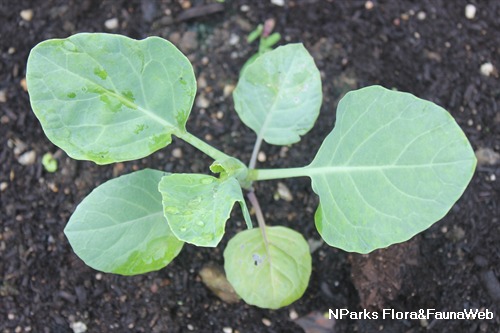.jpg)
Back
Brassica oleracea Alboglabra Group [kailan]
| Family Name: | Brassicaceae (Cruciferae) |
| Common Name: | Kailan, Chinese Broccoli, 芥蓝 |
Name
Classifications and Characteristics
| Plant Division | Angiosperms (Flowering Seed Plants) |
|---|---|
| Plant Growth Form | Herbaceous Plant |
| Lifespan (in Singapore) | Semi-Annual / Annual-Like |
| Mode of Nutrition | Autotrophic |
Biogeography
| Preferred Climate Zone | Sub-Tropical / Monsoonal, Temperate |
|---|---|
| Local Conservation Status | Non-native (Horticultural / Cultivated Only) |
Description and Ethnobotany
| Growth Form | It is a leafy vegetable that grows to about 30 cm tall when harvested. It has thick stems that are smooth and pale green in colour. |
|---|---|
| Foliage | Leaves are waxy, blue-green to dark green in color with prominent veins. Petioles are thick and fleshy. |
| Flowers | Flowers are white and small, produced at the tip of the plant. |
| Cultivation | Grows well in neutral to alkaline, fertile, well-drained soil in full sun. The plant is ready for its first harvest after 21-55 days upon sowing. |
| Ethnobotanical Uses | Edible Plant Parts : Edible Leaves, Edible Flowers Food (Fruit or Vegetable): It is a popular leafy vegetable in Asia. The leaves and stems are harvested for consumption. Gai Lan are commonly stirred fried with oyster sauce in Asian cuisine. |
Landscaping Features
| Landscape Uses | Small Gardens |
|---|---|
| Thematic Landscaping | Economic Garden |
Plant Care and Propagation
| Light Preference | Full Sun |
|---|---|
| Water Preference | Moderate Water |
| Rootzone Tolerance | Moist Soils, Well-Drained Soils, Fertile Loamy Soils |
| Propagation Method | Seed |
| Seed / Spore Germination Duration | 3 days to 5 days |
Foliar
| Mature Foliage Colour(s) | Green - Bluish Green |
|---|
Floral (Angiosperm)
| Flower Colour(s) | White |
|---|---|
| Flower Grouping | Cluster / Inflorescence |
Image Repository
Others
| Master ID | 32725 |
|---|---|
| Species ID | 7137 |
| Flora Disclaimer | The information in this website has been compiled from reliable sources, such as reference works on medicinal plants. It is not a substitute for medical advice or treatment and NParks does not purport to provide any medical advice. Readers should always consult his/her physician before using or consuming a plant for medicinal purposes. |

.jpg)
.jpg)
.jpg)




![Brassica oleracea Alboglabra Group [kailan]_Low Wei Teng](/-/media/ffw/protected/flora/7/1/7137/brassica-oleracea-alboglabra-group-kailan_low-wei-teng-(hortpark)-(1).jpg)
![Brassica oleracea Alboglabra Group [kailan]_Low Wei Teng](/-/media/ffw/protected/flora/7/1/7137/brassica-oleracea-alboglabra-group-kailan_low-wei-teng-(hortpark)-(2).jpg)
![Brassica oleracea Alboglabra Group [kailan]_Low Wei Teng](/-/media/ffw/protected/flora/7/1/7137/brassica-oleracea-alboglabra-group-kailan_low-wei-teng-(hortpark)-(3).jpg)
![Brassica [Kailan]_Low Wei Teng](/-/media/ffw/protected/flora/7/1/7137/brassica-oleracea-alboglabra-group-kai-lan_low-wei-teng-(2).jpg)
![Brassica [Kailan]_Low Wei Teng](/-/media/ffw/protected/flora/7/1/7137/brassica-oleracea-alboglabra-group-kai-lan_low-wei-teng-(3).jpg)
![Brassica [Kailan]_Low Wei Teng](/-/media/ffw/protected/flora/7/1/7137/brassica-oleracea-alboglabra-group-kai-lan_low-wei-teng-(7).jpg)



.jpg)
.jpg)
.jpg)
.jpg)


